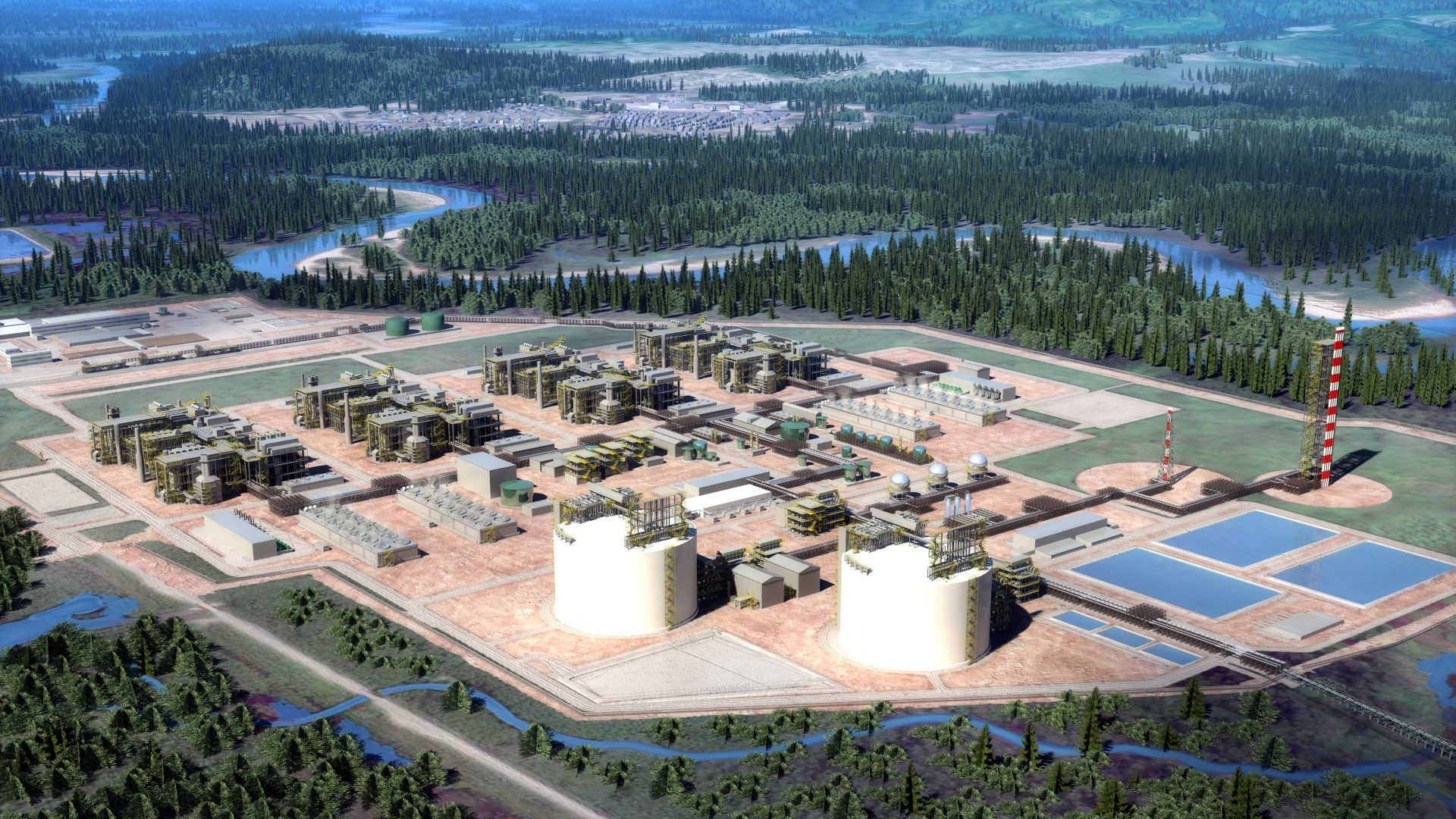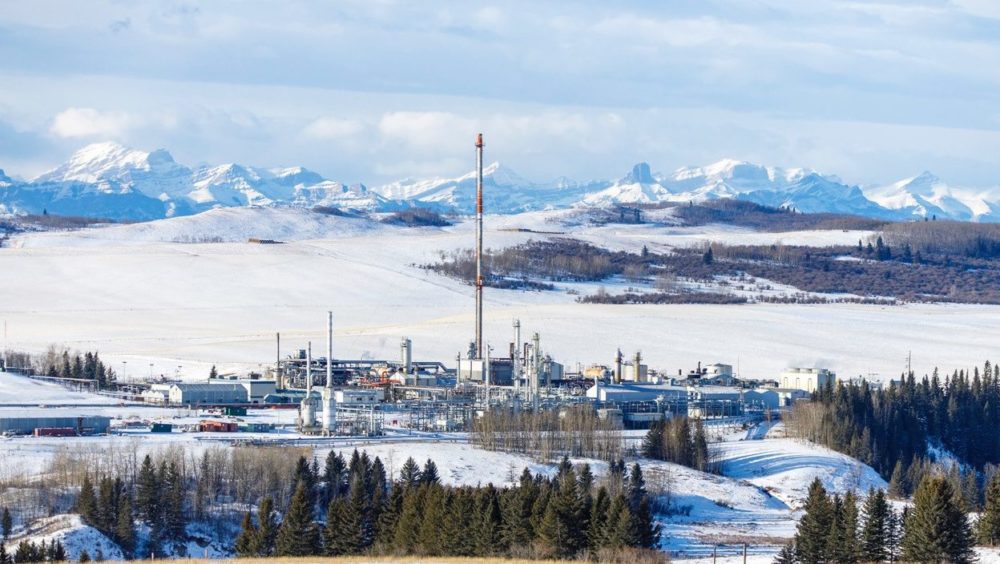Canada poised to provide world’s ‘greenest’ LNG

Artist’s rendering of the LNG Canada export facility being built in Kitimat, B.C. Photograph courtesy LNG Canada
Canada risks losing out on trillions of dollars and the opportunity to help lower global greenhouse gas emissions if can’t overcome ‘self-inflicted’ obstacles to exporting its natural gas to fast-growing Asian countries.
That’s the message in a new report that argues Canada is well positioned to provide competitively priced gas produced according to some of the world’s highest environmental, social and governance (ESG) standards. But the report’s author warns that the uncertainty surrounding Canadian energy policy, combined with ongoing opposition and legal challenges to resource development projects are threatening to hold the country on the sidelines in the race to supply the enormous demand for clean-burning natural gas through liquified natural gas (LNG) exports in the coming decades.
“It may strike non-Canadians as strange that Canada itself is frustrating, if not undermining, its own LNG prospects,” says Peter Findlay, a research associate with the Oxford Institute for Energy Studies and partner with the Criterium Group. “It must seem odd that a country whose economy is so intertwined with, and dependent upon, the safe and environmentally responsible extraction, transportation, and processing of natural resources, takes such an incoherent and ineffectual approach to regulating it.”
Findlay’s report, published by the Oxford institute in December, provides a new analysis of the advantages of Canada’s emerging LNG industry in relation to its international competitors and highlights the biggest hurdles that need to be addressed for the industry to realize its potential.
Natural gas is expected to surpass coal as the world’s second-largest energy source over the next 20 years, with China and India expected to more than double their gas consumption as part of their efforts to reduce GHGs and tackle noxious air pollution.
Western Canadian gas is considered to be the most environmentally responsible supply for Asian markets thanks to short shipping distance from the West Coast, a relatively cold climate that reduces the energy required to cool natural gas to a liquid for overseas transport, use of emission-less hydroelectricity to power LNG facilities, and progressive industry practices and world-leading regulations to limit fugitive methane emissions.
Both Alberta and B.C. have set targets to reduce methane emissions from upstream oil and gas sites by 45 per cent compared to 2014 levels by 2025.
“Canadian LNG is GHG positive; the less Canadian LNG, the higher the GHG emissions along the LNG value-chains that terminate in Asia,” Findlay states. His report adds that comprehensive consultation with Indigenous communities has led to significant Indigenous support and local economic benefits from LNG projects, and that Canada’s stable democratic government and strong reputation for transparency and lack of corruption make Canadian LNG “the most compelling overall ESG story to investors, among all global LNG proponents.”

The Jumping Pound natural gas processing plant west of Calgary was recently acquired by Pieridae Energy as part of the company’s plan to supply Germany and the world with Canadian gas via its proposed Goldboro LNG terminal in Nova Scotia. Photograph for Canadian Energy Centre
Eighteen LNG projects have been proposed in Canada, but only the LNG Canada project in Kitimat, B.C. has begun construction. The project received an export permit and environmental approvals in 2015, approximately two years after it commenced Indigenous consultation activities. Significant work was required to satisfy dozens of regulatory conditions before the joint venture could make a positive final investment decision on Oct. 1, 2018. Findlay says the main reason more projects aren’t underway is because of the ‘onerous complexity’ of Canada’s regulatory system, which has been exacerbated by the uncertainty around the changes made to the federal regulatory process last year through Bill C-69.
“The result is Canada losing out on the order of trillions of dollars in overall macroeconomic impact over the next 40 years, not to mention the opportunity to make a significant reduction in global emissions by displacing the coal burned for electric power in Asia,” Findlay says. “That forgone benefit is simply redirected to more predictable supply jurisdictions, primarily the U.S. Gulf Coast, Russia, Qatar, and East Africa.”
Canada’s success as global LNG player also hinges on a key piece of international climate policy that seeks to define how countries can work together to achieve their GHG reduction targets. Article 6 of the 2015 Paris Agreement has yet to be settled after talks stalled at the United Nations’ COP 25 climate conference in Spain last month. The lack of progress disappointed Canada’s energy sector, as a proposed emissions trading plan for Article 6 would enable Canada to take credit for a portion of the significant GHG reductions that would result from replacing coal with natural gas for electricity generation.
The Canadian Association of Petroleum Producers (CAPP) estimates that using gas instead of coal for new power plants planned over the next 20 years in China, India and Southeast Asia would eliminate 1,500 megatonnes of GHGs per year – more than twice Canada’s current annual emissions.
“This is a missed opportunity and unacceptable, and will only result in increased emissions,” says CAPP’s President and CEO Tim McMillan. “We urge the Canadian government to propose and lead a framework to implement and enable Article 6, allowing countries to trade carbon offset credits and work together to lower global greenhouse gas emissions.”
Findlay agrees, saying it will be difficult for countries to reach agreements to share emissions reductions and to verify that Canadian gas is truly displacing coal, but it is critical to combatting climate change at a global level.
“Something is needed to offset the fact that the Paris Agreement is predicated on individual nation commitments, which is fundamentally incongruent with a global economy,” he says. “Without some benefit to energy exporting countries who help reduce total global emissions, Canadians will have to accept an increase in their own emissions for the greater good of reducing global emissions.”
About the Canadian Energy Centre (CEC)
The Canadian Energy Centre (CEC) is an independent provincial corporation that is primarily supported by the Government of Alberta’s industry-funded Technology, Innovation and Emissions Reduction (TIER) fund. The CEC’s mandate is to promote Canada as the supplier of choice for the world’s growing demand for responsibly produced energy. At its core, the CEC will also create a new, pragmatic, fact-based narrative about Canadian energy.
Visit the Canadian Energy Centre website
Share This:





 CDN NEWS |
CDN NEWS |  US NEWS
US NEWS 



































COMMENTARY: Activists Suddenly Care About LNG Investors